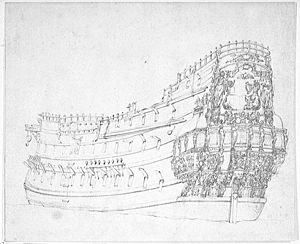HMS Victory (1620) facts for kids

Portrait of Victory by Willem van de Velde the Elder, 1655
|
|
Quick facts for kids History |
|
|---|---|
| Name | Victory |
| Ordered | 10 March 1620 |
| Builder | William Burrell, Deptford Dockyard |
| Launched | 1620 |
| Commissioned | 1627 |
| Fate | Broken up, 1691 |
| Notes | |
| General characteristics as built | |
| Class and type | 42-gun great ship |
| Tons burthen | 87079⁄94 bm |
| Length | 108 ft 0 in (32.92 m) (keel) |
| Beam | 35 ft 9 in (10.90 m) , later raised (probably through girdling) to 37 ft 6 in (11.43 m) |
| Depth of hold | 17 ft 0 in (5.18 m) |
| Sail plan | Full-rigged ship |
| Complement | 260–300 |
| Armament | 42 guns |
| General characteristics after 1666 rebuild | |
| Class and type | 82-gun second-rate ship of the line |
| Tons burthen | 1029 74⁄94 bm |
| Length | 121 ft (37 m) (keel) |
| Beam | 40 ft (12 m) |
| Depth of hold | 17 ft 6 in (5.33 m) |
| Sail plan | Full-rigged ship |
| Armament | 82 guns of various weights of shot |
The Victory was a powerful warship of the English Navy. It was launched in 1620. This ship was very active during the Anglo-Dutch Wars in the 1600s. After serving for 70 years, Victory was taken apart in 1691. Its wood was then used to build other ships.
Contents
Building and Early Missions
The Victory was designed by a naval architect named Phineas Pett. It was built by Andrew Burrell at Deptford Dockyard. The ship was launched on October 10, 1620. It had 42 guns and a crew of 270 sailors.
In 1621, Victory was sent on its first mission. It joined a fleet led by Admiral Robert Mansell. Their job was to sail the Mediterranean Sea. They were looking for pirates from Algeria. The fleet returned to England later that year. Victory then patrolled the English Channel. This helped protect merchant ships crossing from Europe.
In May 1622, Victory became the main ship, or flagship, for the Earl of Oxford. He wanted to clear pirates from the seas near Dunkirk. However, this mission was not successful. They did not find any pirates during their trip.
Fighting in the First Dutch War
Victory was called back into service in 1627. It was commanded by Captain Thomas Kettleby. The ship took part in an attack on La Rochelle, which did not succeed.
During the First Anglo-Dutch War, Victory was led by Captain Lionel Lane. It fought in several important battles:
- The Battle of Dover in May 1652.
- The Battle of Dungeness in November 1652.
- The Battle of Portland in February 1653.
- The Battle of the Gabbard in June 1653.
- The Battle of Texel in July 1653.
By 1660, the Victory had been upgraded. It now carried 56 guns.
Rebuilding and the Second Dutch War
By 1665, Victory was not actively sailing. It was kept in a reserve fleet at Chatham Dockyard. In 1666, the ship was rebuilt there by Phineas Pett II. It became an 82-gun second-rate ship of the line. This meant it was a very large and powerful warship.
After being rebuilt, Victory was commanded by Sir Christopher Myngs. It fought in the Four Days Battle in 1666. Sir Christopher Myngs was sadly killed during this battle. On July 25, 1666, the ship fought again. This was the St. James's Day Battle, under Sir Edward Spragge.
During the St. James's Day Battle, Victory was part of the English fleet's rear section. It was too far south to join the early fighting. The ship helped another English vessel, the HMS Loyal London, when it caught fire. Two of Victory's crew members showed great bravery. The second in command, 18-year-old John Wilmot, 2nd Earl of Rochester, bravely carried messages to another ship. He did this while under heavy enemy fire. The ship's chaplain, Reverend Speed, also helped. He left the area where he was helping the wounded. Instead, he joined the crew in loading and firing the cannons. The crew later made a song about him. It said he was "praying like a Christian while fighting like a Turk."
After the battle, Victory returned to the Thames River for repairs. In June, the Dutch fleet surprised the English. They launched a Raid on the Medway. Victory was not ready for battle. To stop the Dutch from capturing or burning it, the ship was quickly towed to shore. It was then sunk in the mud. This act of sinking a ship to protect it is called "scuttling."
Scuttling made the ship's condition worse. Even after being refloated and repaired, it took a long time. Victory was not ready to sail again until 1668.
Fighting in the Third Dutch War
During the Third Dutch War, Victory continued to serve. It took part in several more battles:
- The Battle of Solebay on May 28, 1672, under Lord Ossory.
- The two Battles of Schooneveld on May 28 and June 4, 1673, under Sir William Jennens.
- The Battle of Texel on August 11, 1673, also under Sir William Jennens.
By 1685, the ship's weapons were reduced to 80 guns. Victory was finally taken apart in 1691 at Woolwich Dockyard.

